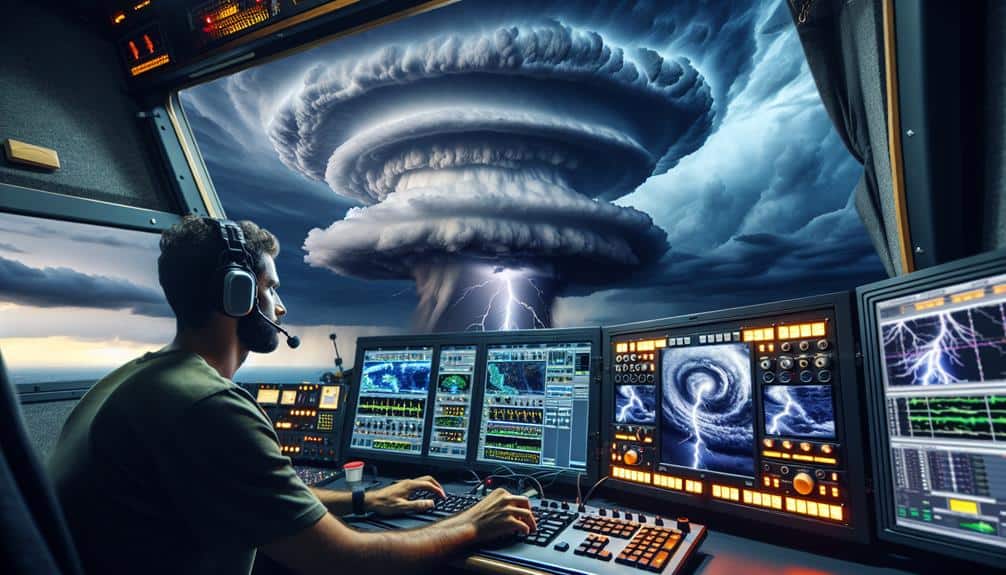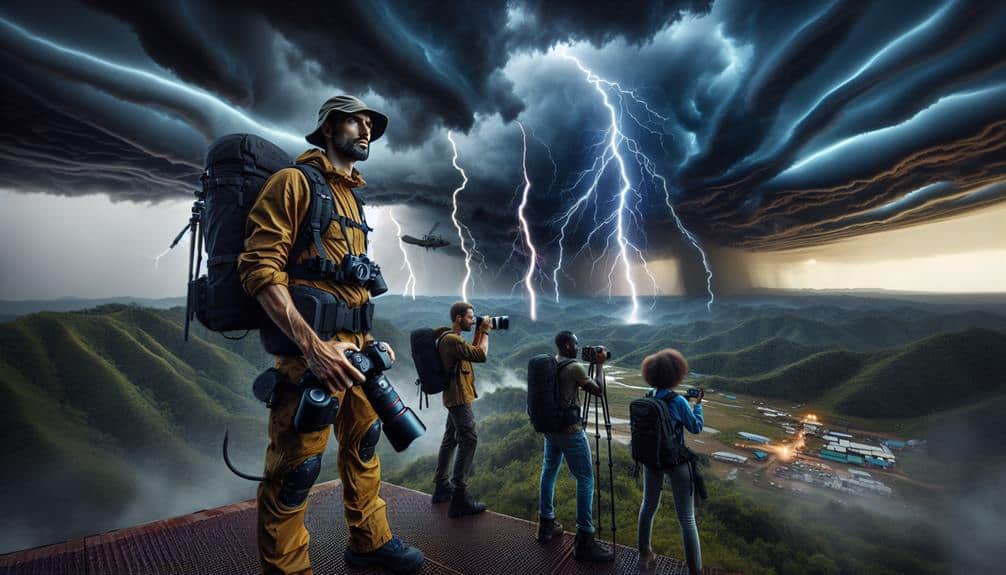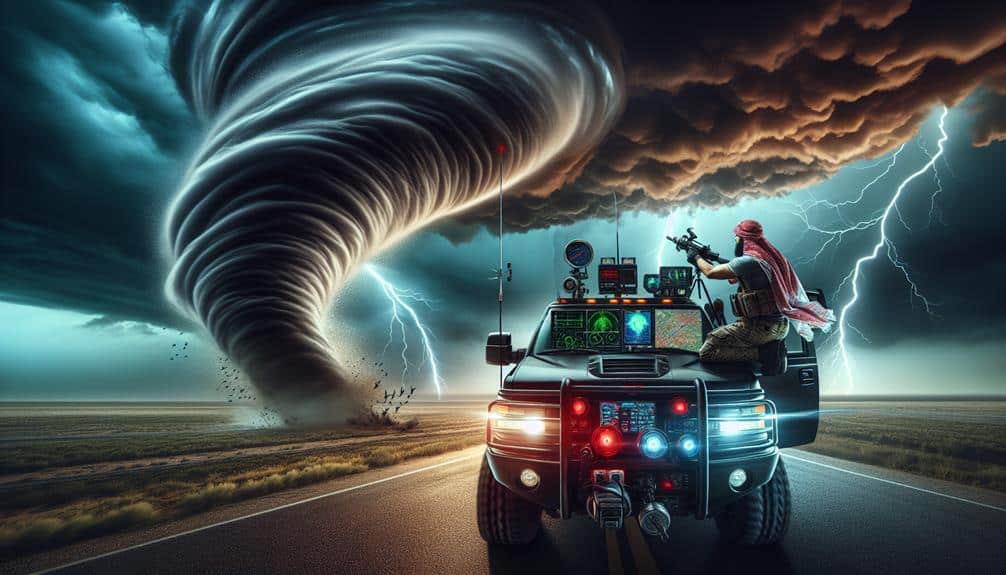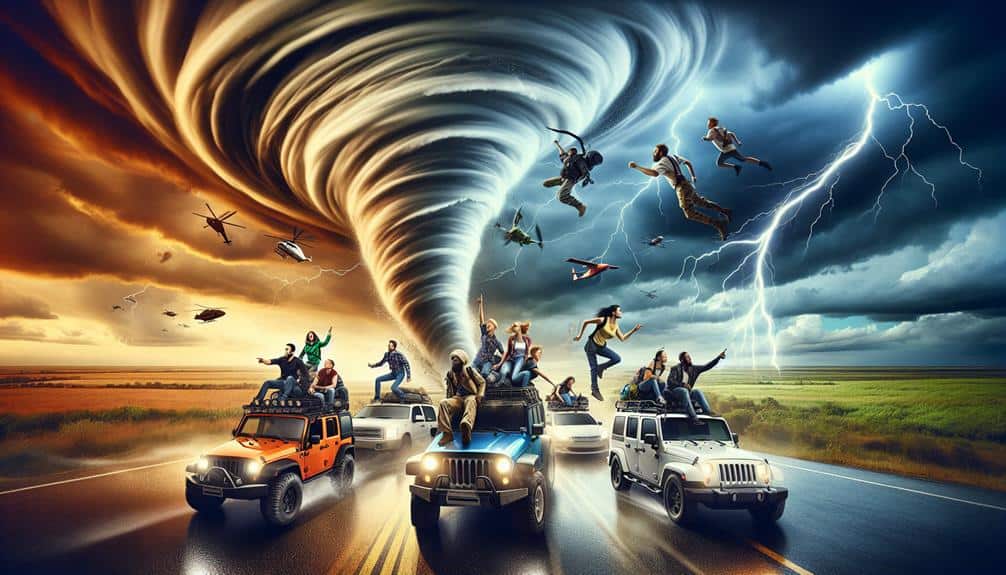We must stay updated on weather risks to maximize our effectiveness and safety as storm chasers. Real-time atmospheric data analysis lets us accurately predict storm behavior, leveraging variables like temperature, humidity, and wind speed. Utilizing real-time updates and GPS technology ensures dynamic positioning and heightened situational awareness. Historical data aids in identifying high-risk zones, optimizing our chase paths. We need to incorporate machine learning algorithms and high-detail numerical models for precise storm path predictions, enhancing risk management. Staying informed with the latest meteorological shifts guarantees we remain equipped for efficient, safe pursuits. Discover more insights on storm chasing methodologies.
Key Points
- Real-time updates enhance situational awareness and allow for better decision-making during storm chases.
- Accurate weather information helps mitigate risks and ensures the safety of storm chasers.
- Up-to-date data allows for the optimization of chase strategies, increasing the likelihood of successful storm interception.
- Staying informed on weather risks helps in dynamically adjusting positioning to evade dangerous conditions.
Understanding Weather Patterns
Understanding weather patterns requires us to analyze atmospheric data meticulously to predict storm behavior accurately. By examining variables like temperature, humidity, and wind speed, we can develop precise storm prediction models. These models are essential for understanding how climate trends influence weather events. As storm chasers, our freedom to explore depends on our ability to interpret these data points correctly.
Atmospheric conditions play a pivotal role in storm development. For instance, a sudden drop in air pressure can indicate an impending storm, while variations in temperature gradients often signal severe weather. By correlating these atmospheric parameters with real-time data, we can forecast storms with greater accuracy. Geographic influences also come into play; mountainous regions, coastal areas, and plains each exhibit unique weather patterns due to their topographical features.
Incorporating climate trends into our analysis allows us to identify long-term shifts that could impact storm frequency and intensity. By understanding these broader patterns, we can better anticipate future atmospheric conditions. Ultimately, our goal is to use this data-driven approach to enhance our storm prediction capabilities, ensuring we can navigate and chase storms safely while enjoying the liberty to pursue our passion.
Enhancing Safety Measures
As we refine our storm prediction models with precise atmospheric data, it's essential to implement robust safety measures to protect ourselves in the field. By leveraging advanced data analytics, we can enhance risk reduction strategies, guaranteeing we're well-prepared for any scenario.
Utilizing real-time weather updates and integrating them with GPS technology, we can dynamically adjust our positions to avoid the most hazardous parts of a storm system.
Risk reduction starts with thorough preparation. We equip our vehicles with necessary safety gear, including first-aid kits, communication devices, and emergency lighting. Additionally, having a detailed emergency response plan is vital. This includes predefined evacuation routes, safe meeting points, and protocols for communication breakdowns.
Incorporating historical data also aids in identifying high-risk zones and optimizing our chase paths accordingly. By analyzing past storm behaviors, we can predict potential hazards with greater precision.
It's crucial that we stay connected with local emergency services. Establishing a direct line of communication ensures that we receive timely alerts and can coordinate effectively during critical situations. Ultimately, our goal is to maximize our freedom to chase while minimizing our exposure to unnecessary risks.
Optimizing Chase Strategies
To optimize our pursuit strategies, we analyze real-time meteorological data and historical storm patterns to pinpoint the most promising locations for intercepting severe weather events. By leveraging advanced modeling techniques, we can predict storm trajectories with greater accuracy. This allows us to position ourselves effectively for storm interception while minimizing unnecessary risk.
Our risk assessment process involves a multi-faceted approach. We evaluate variables such as wind shear, humidity levels, and temperature gradients to assess the likelihood of tornado formation or severe thunderstorms. By integrating data from Doppler radar, satellite imagery, and surface observations, we develop a thorough understanding of the storm environment.
We also utilize historical storm data to identify patterns and trends that inform our strategic decisions. For instance, knowing the frequency and intensity of past storms in a given region helps us prioritize high-probability areas for interception. This data-driven approach not only enhances our chances of capturing compelling footage but also ensures we maintain a balance between thrill-seeking and safety.
Real-Time Data Utilization
We leverage an array of real-time data sources, including Doppler radar, satellite feeds, and ground-based sensors, to make informed decisions during our storm chases. Utilizing these technologies allows us to conduct precise data analysis, ensuring we maximize both safety and efficiency. Our technology integration is crucial for interpreting meteorological phenomena as they unfold, enabling us to react swiftly to rapidly changing conditions.
By incorporating real-time data, we benefit in several critical ways:
- Enhanced Situational Awareness: Immediate updates from Doppler radar and satellite feeds provide us with the latest storm trajectories and intensity levels, facilitating on-the-spot decision-making.
- Improved Risk Management: Ground-based sensors offer granular data on factors such as wind speed and barometric pressure, helping us assess potential risks in real time and adjust our strategies accordingly.
- Optimized Resource Allocation: Real-time data enables us to allocate our resources—vehicles, personnel, and equipment—more effectively, ensuring we're positioned efficiently for both data collection and personal safety.
With these advanced data analysis techniques and technology integration, we can pursue our passion for storm chasing while maintaining a high level of operational excellence. By staying updated with real-time information, we enjoy the freedom to chase storms more strategically and safely.
Improving Forecast Accuracy

Building on our use of real-time data, enhancing forecast accuracy becomes essential by integrating machine learning algorithms and high-detail numerical models into our predictive tools. Leveraging these advanced methodologies, we can refine our data analysis processes, allowing us to predict storm paths with greater accuracy.
By utilizing machine learning, we identify patterns and trends within historical weather data that were previously undetectable, optimizing our predictive modeling capabilities. Our approach involves training algorithms on vast datasets encompassing various meteorological variables such as temperature, humidity, wind speed, and more. These algorithms, through iterative learning, improve their predictive precision over time.
High-detail numerical models further enhance this process by providing detailed simulations of atmospheric conditions, enabling us to visualize potential storm developments in exceptional detail. Data analysis becomes more robust as we incorporate diverse sources, from satellite imagery to ground-based radar systems, ensuring a thorough understanding of evolving weather patterns.
This integration not only sharpens our forecasts but also grants us the agility to adapt to sudden meteorological shifts, an important advantage for storm chasers who value freedom and flexibility. By embracing these advanced tools, we position ourselves at the forefront of meteorological forecasting, ensuring both safety and efficiency in our pursuits.
Frequently Asked Questions
How Do Storm Chasers Communicate During Severe Weather Events?
We use emergency protocols and real-time data to communicate during severe weather events. By leveraging satellite phones, radio frequencies, and GPS tracking, we guarantee safety precautions are followed, enhancing our ability to operate freely and effectively.
What Equipment Is Essential for Storm Chasers?
We rely on essential equipment like safety gear and tracking devices for accurate data collection and personal protection. Safety gear includes helmets and sturdy clothing, while tracking devices provide real-time storm data, enhancing decision-making and ensuring our freedom.
How Do Storm Chasers Document Their Findings?
We capture Mother Nature's whims using advanced data collection instruments and refined photography techniques. Our documentation process involves high-resolution imagery, precise meteorological data, and real-time video, ensuring we accurately record and analyze every atmospheric nuance for future insights.
What Are the Legal Considerations for Storm Chasing?
When storm chasing, we must consider legal implications and adhere to safety protocols. By analyzing local laws and ensuring compliance, we protect our freedom to chase while minimizing risks to ourselves and others.
How Do Storm Chasers Fund Their Expeditions?
We fund our expeditions through diverse funding sources and sponsorships, meticulously budgeting for equipment costs. Analyzing data helps us secure necessary resources while maximizing financial freedom, ensuring we can chase storms efficiently and safely.


